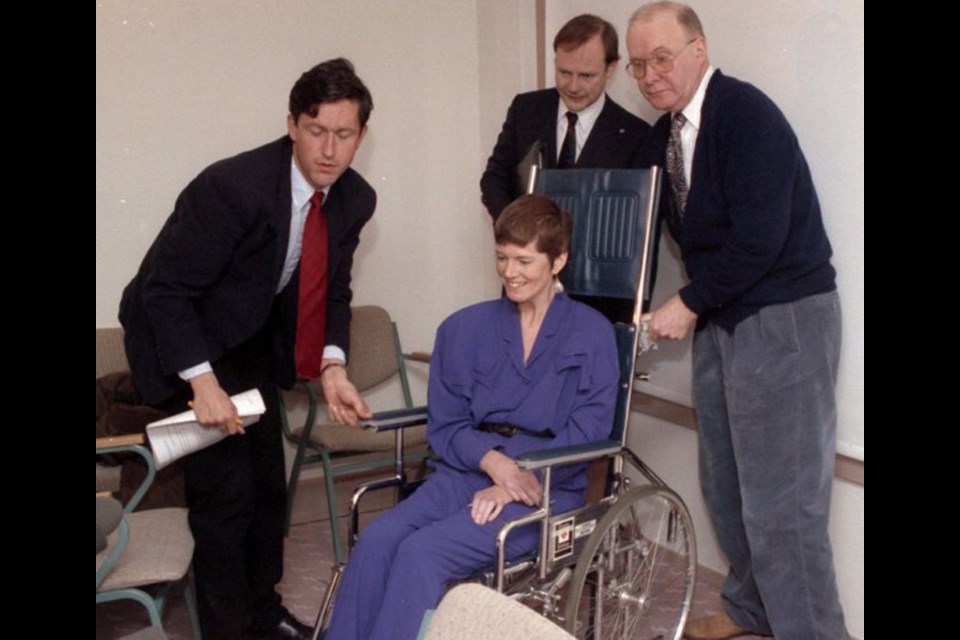A Good Death: Making the Most of Our Final Choices
By Sandra Martin
Patrick Crean / HarperCollins, 386 pp., $27.99
The headline on the front page of the Times Colonist on Dec. 18, 1992, was straightforward; “Woman asks to command own death.”
The story below the headline quoted the words Sue Rodriguez said to B.C. Supreme Court Justice Allen Melvin: “I want to be in charge of my life and my death.”
Rodriguez was dying of amyotrophic lateral sclerosis, and was asking for the right to have a doctor-assisted suicide, with the doctor providing the technical means which she could activate.
“I don’t want to die a gruesome death of trying to get air or go into a choking spasm or starve,” she told the court. “I feel that it’s my right to die with dignity.”
Twelve days later, another headline — “Rodriguez denied MD-aided suicide” — told of her failure to persuade the judge that the Criminal Code section barring anyone from helping another person commit suicide was a violation of her rights.
Melvin said that the right to commit suicide was not constitutionally guaranteed, and that barring someone from helping another to commit suicide was justified in a free and democratic society.
Rodriguez, with the support of right-to-die advocates, took her fight to the B.C. Court of Appeal, and then to the Supreme Court of Canada. She lost at every step, but was able to commit suicide, with the help of an unnamed person, in February 1994.
Through the efforts of Rodriguez and others, British Columbia has been at the forefront of the debate over assisted suicide — a debate that has continued for almost a quarter of a century. In February, John Hofsess, who had supported Rodriguez in her legal battles, went to a clinic in Switzerland to end his own life.
As the boomer generation ages, we are sure to hear more about the concept of assisted suicides, and it is a conversation that Canadians need to have.
The discussion will surely by fuelled by the publication of A Good Death: Making the Most of Our Final Choices, by Toronto writer Sandra Martin.
Martin provides a detailed account of what has happened since the Rodriguez case, including the work of Hofsess and his partner Evelyn Martens, as well as the cases involving Kay Carter and Gloria Taylor.
She also helps explain the background to this discussion, with examples of people who have debilitating illnesses and are, quite simply, anxious to go. She also helps us to understand more about the process of helping someone die, and the safeguards that are in place to ensure that euthanasia is not being forced on people.
This book is highly relevant these days because of Bill C-14, which would legalize assisted suicide and was the result of a a landmark 2015 Supreme Court of Canada ruling.
Martin’s book also goes into detail about the work of Hofsess through the years, including his role in the death of poet Al Purdy. Hofsess cited the imminent publication of the book as a reason to go ahead with his own suicide, since he was worried that he could prosecuted for what he did.
In reality, while Martin pulls no punches about Hofsess and Purdy, it would be difficult to base a criminal case on one paragraph in a book. Besides, Hofsess had not been reluctant to talk with several other people about his role in the death of Purdy, so his fears about the book should be discounted.
In A Good Death, Hofsess does not emerge as a likable character. He grabbed onto the Rodriguez case early, and seemed determined to ride it for his own purposes, and use publicity about Rodriguez to further his right-to-die campaign.
Hofsess and Rodriguez signed a deal allowing him to publicize her situation, and her legal battles.
It was Hofsess — described by Martin has “a loner with an agenda” — who scripted the unforgettable line “who owns my life?”
Later, Hofsess wrote a column using off-the-cuff comments by Rodriguez, signed it with shaky letters SR, and faxed it to the media. That was a clear ethical breach, one Hofsess apologized for, but it raised a bizarre notion: Rodriguez was fighting for the right to control her own life, but someone in theory on her side was trying to control her words.
After Hofsess spoke for Rodriguez without her consent again, she distanced himself from him, and NDP MP Svend Robinson started to handle communications.
Hofsess can’t answer for his actions, although his own suicide should be used as part of any discussion on assisted death.
Hofsess was not terminally ill. It could be argued that his suicide was one of convenience rather than one of necessity.
His case is, therefore, quite different from those of Sue Rodriguez, Gloria Taylor, Kay Carter, Brittany Maynard and the others in A Good Death. It should be considered in a different way.
Martin’s A Good Death is an important book, exploring a topic that is far more complex that one might expect.
It is an emotional topic that has enormous legal and medical ramifications. Religion needs to be considered. Politicians will need to be involved, and will need to set aside their personal beliefs, if they can, and think of the common good.
This is a conversation we need to have. A Good Death will help guide us through it.
The reviewer is editor-in-chief of the Times Colonist.



